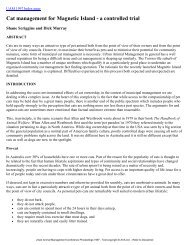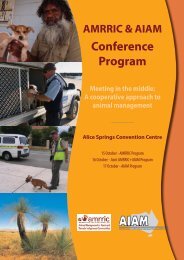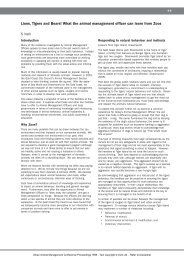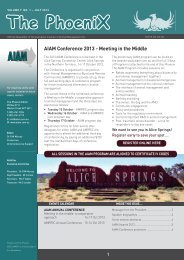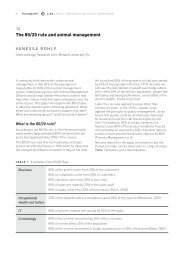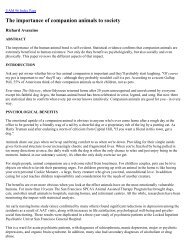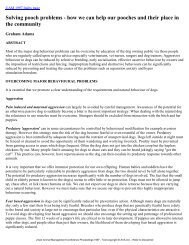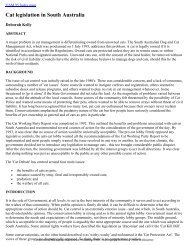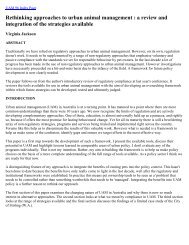Proceedings OF ThE - Australian Institute of Animal Management Inc
Proceedings OF ThE - Australian Institute of Animal Management Inc
Proceedings OF ThE - Australian Institute of Animal Management Inc
You also want an ePaper? Increase the reach of your titles
YUMPU automatically turns print PDFs into web optimized ePapers that Google loves.
Annual Conference on <strong>Animal</strong> <strong>Management</strong> AIAM <strong>Proceedings</strong> 2012 99<br />
Solving common behaviour problems<br />
Behaviour problems are best solved when<br />
their cause is understood. Causes may include<br />
natural drives or learned behaviours and also the<br />
environment the pet lives within.<br />
One <strong>of</strong> the most common unwanted behaviours in<br />
dogs is barking (Righetti, 2012a). Barking may be<br />
an instinctive behaviour in dogs, to communicate<br />
to other individuals – dog or human – but it can be<br />
difficult to understand just why some need to bark<br />
so <strong>of</strong>ten or for such great lengths <strong>of</strong> time. Barking is<br />
also a leaned behaviour, dogs using this behaviour to<br />
have an impact on their environment.<br />
Barking, in fact, is a symptom and we need to<br />
understand its cause. Once it is understood that a<br />
dog is bored or anxious or is responding to events in<br />
the environment or is seeking their owner’s attention,<br />
then strategies can be put in place to reduce the<br />
unwanted barking.<br />
Solutions to behaviour problems generally include:<br />
• yShort-term management strategies to ensure<br />
the safety <strong>of</strong> the animals that the undesirable<br />
behaviour impacts and to provide immediate<br />
reduction, if possible, <strong>of</strong> the unwanted behaviour.<br />
• yLong-term solutions which address the needs<br />
<strong>of</strong> the animal, provide appropriate outlets for<br />
their drives and teach the pet a more desirable<br />
behaviour.<br />
Short-term management <strong>of</strong> barking may include the<br />
use <strong>of</strong> anti-barking devices or relocating the dog to<br />
a different area <strong>of</strong> the home to prevent barking at<br />
certain times <strong>of</strong> the day. Long-term solutions may<br />
include relieving the dog’s anxiety, providing outlets<br />
for their energy or teaching them to be quiet.<br />
Other common dog behaviour problems such as<br />
aggression (Righetti, 2012b) and anxiety (Righetti,<br />
2012c), over being alone or meeting other dogs for<br />
instance, can also be addressed by following a shortterm<br />
management strategy and long-term goal<br />
implementation. Cat behaviour problems such as<br />
anxiety (Righetti 2012d) or toileting issues (Righetti<br />
2012e) can also be addressed this way.<br />
References<br />
Bradshaw, J. (2011). In Defence <strong>of</strong> Dogs. Allen Lane.<br />
McGreevy, P.D. & Boakes, R.A. (2007). Carrots and Sticks:<br />
Principles <strong>of</strong> <strong>Animal</strong> Training. Cambridge University Press.<br />
McGreevy, P.D. (2009). A Modern Dog’s Life. UNSW Press.<br />
Righetti, J. (2012a). Barking Problems Solved. Longueville Books.<br />
Righetti, J (2012b). Dog Aggression Problems Solved. Longueville<br />
Books.<br />
Righetti, J (2012c). Dog Anxiety Problems Solved. Longueville Books.<br />
Righetti, J. (2012d). Cat Anxiety Problems Solved. Longueville<br />
Books. To be published.<br />
Righetti, J. (2012e). Cat Toileting Problems Solved. Longueville<br />
Books. To be published.<br />
About the author<br />
With a passion for pets and extensive knowledge <strong>of</strong><br />
human–animal relationships, animal behaviourist<br />
Dr Joanne Righetti consults with pet owners,<br />
councils, commercial companies and not-forpr<strong>of</strong>it<br />
organisations. She is a also a regular radio<br />
guest, a speaker aboard P&O cruises and also<br />
hosts interactive sessions at numerous pet events.<br />
Joanne attracts significant following on digital and<br />
social media, including a website, blog, twitter<br />
and facebook. Her latest venture is a series <strong>of</strong> pet<br />
behaviour books tacking common issues such as<br />
barking, anxiety and aggression. More about<br />
Dr Jo and her business Pet Problems Solved at<br />
www.joannerighetti.com<br />
Contact<br />
Dr Joanne Righetti<br />
Email: drjoanne@petproblemsolved.com.au<br />
. . . . . . . . . . . . . . . . . . . . . . . . . . . . . . .<br />
. . . . . . . . . . . . . . . . . . . . . . . . . . . . . . .<br />
. . . . . . . . . . . . . . . . . . . . . . . . . . . . . . .<br />
. . . . . . . . . . . . . . . . . . . . . . . . . . . . . . .<br />
. . . . . . . . . . . . . . . . . . . . . . . . . . . . . . .<br />
. . . . . . . . . . . . . . . . . . . . . . . . . . . . . . .<br />
. . . . . . . . . . . . . . . . . . . . . . . . . . . . . . .<br />
. . . . . . . . . . . . . . . . . . . . . . . . . . . . . . .<br />
. . . . . . . . . . . . . . . . . . . . . . . . . . . . . . .<br />
. . . . . . . . . . . . . . . . . . . . . . . . . . . . . . .<br />
. . . . . . . . . . . . . . . . . . . . . . . . . . . . . . .<br />
. . . . . . . . . . . . . . . . . . . . . . . . . . . . . . .<br />
. . . . . . . . . . . . . . . . . . . . . . . . . . . . . . .<br />
. . . . . . . . . . . . . . . . . . . . . . . . . . . . . . .<br />
. . . . . . . . . . . . . . . . . . . . . . . . . . . . . . .



